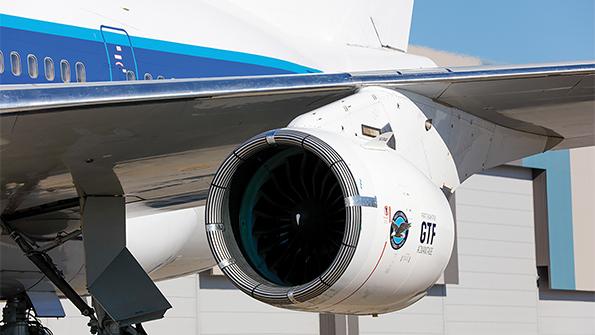
With three in-service applications, Pratt & Whitney’s geared turbofan (GTF) development strategy is already well-established, but the company has seized the coming debut of the longer-range Airbus A321XLR as a chance to launch the engine’s first considerable performance evolution.
Dubbed the GTF Advantage, the PW1100G performance improvement package is targeted at higher thrust and lower fuel burn without affecting durability. Rated up to 34,000 lb. thrust, the package will make Pratt’s engine the most powerful option available on the Airbus A320neo family from its targeted debut of January 2024. Incorporating a set of materials, design and airflow upgrades in the low- and high-pressure spools, the Advantage will also be compatible with 100% sustainable aviation fuel (SAF) at entry into service.
- Certification targeted for mid-2023
- Goal is to boost A321neo performance
Representing the first significant refresh of the core since certification testing of the production-standard PW1100G began in 2012, the Advantage is aimed at increasing the company’s market share of the A320neo family—particularly the longer-range A321XLR. Airbus is on track to deliver the first of these in 2023 and has already secured firm commitments for more than 500 aircraft—many of which have yet to be allocated an engine choice between the GTF and CFM’s competing Leap 1A.
“We think that with the hardest part behind us, which is the geared architecture, now we can spiral in additional technologies and continue to improve the product over time,” says Carroll Lane, president of commercial engines at Pratt & Whitney. Initial ground tests began quietly in mid-2020, and flight tests on the company’s Boeing 747SP flying testbed are now underway. “We’ve got a lot of data coming off the engine tests, and we like what we’re seeing so far,” he adds.
Developed with the growing A321neo operator base in mind, the Advantage package “is very much responsive to market requirements,” Lane says. “Operators are asking for longer range, better efficiency and hot-and-high performance. When we conceived the GTF Advantage, we really wanted to be able to address that additional 34,000-lb.-thrust requirement—which is about a 4% improvement at sea level and up to 8% at higher elevations—without just running the engine hotter. This is going to be an important enabler for that [A321XLR] product line.”
The main changes include increasing core airflow, particularly through modifications to the low-pressure compressor. “We’re doing this without just increasing the temperature, so you get all the durability of the GTF as it exists today—which is a much more durable product than when it entered service. But you also have this available thrust, and all the while you get a 1% fuel-consumption benefit, which in our industry is a big deal,” says Lane.
The new standard engine will also be interchangeable with the current production version—which it will displace on the assembly line starting around late 2023. Intermixing of the cooler-running Advantage with the current PW1100G at derated thrust settings will also increase time on wing, reducing maintenance costs, adds Lane. “It provides a ton of flexibility for operators and is really an important part of our philosophy in bringing this to market,” he says.
Building on improvements to the low-pressure turbine introduced to counter durability problems on the base engine, the package increases the flow through the core by supercharging the three-stage low-pressure compressor. “We are also modifying the turbine areas to enable that flow to cool down the entire core of the engine—increasing the flow through the high-pressure compressor—and doing it in a way that maintains the operability margins that we want in the engine,” says Tom Pelland, senior vice president of GTF engines at Pratt & Whitney.
As well as improving the aerodynamics of the blades in the three low-pressure compressor stages, the package rematches the flow with the turbines by changing the frontal area of the two-stage high-pressure turbine and the three-stage low-pressure turbine. “We are also improving the aerodynamics of the high-pressure compressor for the performance gains that we’re working,” Pelland says. “In the high-pressure turbine, we have got some advanced airfoil casting geometries that we’re leveraging that are enabling us to reduce the amount of flow we need into the turbine, which is also being benefited by the lower core temperatures that are enabled by the increased flow.”
Since ground tests began in mid-2020, the Advantage configuration has amassed 983 total hours and 987 cycles, of which 164 flight hours and 21 flight cycles have been accumulated on the 747SP. In tests so far, “the fundamentals of the engine look very good,” Pelland says. “The temperature reductions we were looking for are as expected, and the performance level is within our expectations. The operability signature looks good.” Pratt is targeting FAA Part 23 engine certification in mid-2023.






Comments